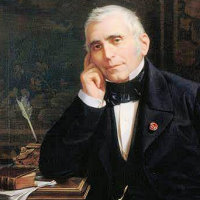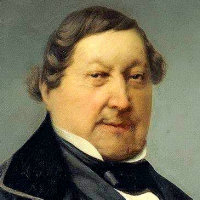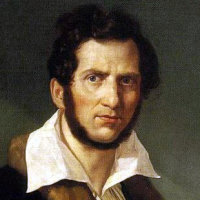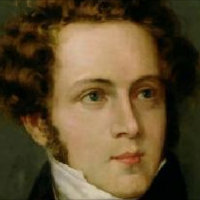| Handout (flat) Handout (folded) Class Script | Return to Index |
Q AND A
I have trouble using the links
This question was actually asked by somebody in another course, but it made me realize that what worked
best for me on a Windows desktop computer might not be ideal for other devices. So I have changed
the way that links work. Instead of opening in a new window, they now take over from the current page.
So just use the back button or arrow to return to it.
What other approaches to the bedroom scene are there?
The two full productions other than the Met that I list below (one of which has the same tenor) also use
a degree of physical foreplay: here is the scene at Pesaro
in 2024, and (albeit in poor video) at Glyndebourne in 1997.
Two that try slightly less explicit approaches are an earlier one from
Pesaro in 2009 and a 2010
production in Hungary. It occurs to me, incidentally, that this scene would be impossible if the role of
Isolier were sung by a man: making him a travesty role ensures that as a male character, he can make
love to Adele, while the casting with a female singer takes the sting out of Ory making love to her!
What is the history of the "pants-role"?
I was wrong in suggesting that it goes back to Monteverdi; in Poppea (1642), for example, he uses a
tenor for the role of the page. But that was because the tenor was not yet the big heroic voice it became in
Romantic opera. In Handel's Giulio Cesare (1724), for example, the heroic male roles such as Julius
Caesar were taken by the big stars—castrati—while the young man's role of Sesto was indeed sung by a
woman. The first iconic pants-role is probably Cherubino in Mozart's Marriage of Figaro (1786), a
teenager in total thrall to his hormones. The largest trouser role of all is surely Octavian, the title
character in Der Rosekavalier (1911), by Richard Strauss; the role of the Composer in his Ariadne
auf Naxos (1912) is equally important, but figures only in the first act. The title role of the Child
in Ravel's L'enfant et les sortilèges (1925), which we will be hearing later in the semester, is also
written for a mezzo-soprano, though it is relatively small.
When was the last castrato?
The last operatic castrato role ever written was Armando in Meyerbeer's Il crociato in Egitto of
1824. The last castrato to survive was Alessandro Moreschi, who sang in the Sistine Chapel choir. He is
also the only one to make a solo recording; you
should realize, however, that (a) in 1902, recording technique was still in its infancy; (b) Moreschi would
have been 46 and past his prime; and (c) that he was never an opera singer. Nowadays, such roles are taken by
countertenors, normally virile men who have developed the upper register, to such an extent that many modern
composers now write specifically for the countertenor voice. But they do not have the unique combination of
soprano voice and tenor physique that made the voice so extraordinary. For the film Farinelli, the
voice of American countertenor Derek Lee Ragin (briefly a student of mine) was blended electronically
with that of a dramatic soprano to create some spproximation of the sound; you can hear the result
here.
VIDEO LINKS
The good news: the 2011 Metropolitan Opera production of Le Comte Ory is available on YouTube, both complete and in several shorter excerpts. The bad news: the video quality is not great, and only one scene has English titles. So I also include a link to where you may buy the DVD set on Amazon; it is about $27, which is not bad for a 2-disc set.
I also include links to two other complete productions (though neither with English titles), almost diametrically opposite in approach. One comes from the Rossini Opera Festival in Pesaro, and is modern, sparkling, and clear. It is well worth a look for its quite unusual design inspired by Heironmyus Bosch, and inventive approach to staging throughout; it features the same tenor, Juan Diego Flórez. For comparison purposes, I have given cues to the equivalent sections we watched in class.
The other is a production from my own alma mater, Glyndebourne, which I think was the first company to mount a modern revival of the opera. Unfortunately, this version has little of the sparkle of that 1956 production; this one has old-fashioned costumes and scenery, and singers who (at least in close-up) make little attempt to hide their age. But it is musically excellent, and I wonder (though without proof) if it was actually devised as a return to what the premiere might have looked like in 1828. So I have included it for that reason, as a straight performance that puts the emphasis where it belongs: on the music.
| METROPOLITAN OPERA, 2011 | |||
| Complete |
YouTube video
(no titles) Amazon purchase (about $27) |
||
| Scenes |
Ory's entrance as the Hermit Act I finale (this has titles!) Bedroom scene |
||
| OTHER PRODUCTIONS | |||
| Pesaro, 2024 |
Complete
(see note above and image below) — Ory's entrance as the Hermit — Isolier/Ory duet — Adèle's Act I entrance — Adèle/Ory Act II duet — drinking song — bedroom scene |
||
| Glyndebourne, 1997 | Complete (see note above) | ||

The bedroom scene at Pesaro (see link above)
















